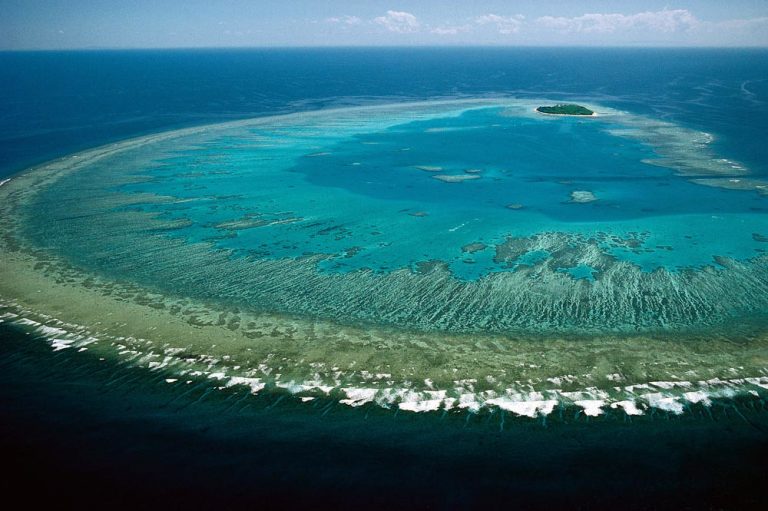Syllabus:
GS3: Conservation, environmental pollution and degradation, environmental impact assessment
Context: The Great Barrier Reef has experienced its greatest annual loss of live coral across most of its expanse in four decades of record-keeping, according to Australian authorities.
More on the News
- Australian Institute of Marine Science reported that, the living coral cover shrank by almost a third in the south in a year, a quarter in the north and by 14% in the central region, the largest annual coral loss in 39 years.
- According to the U.S. National Oceanic and Atmospheric Administration’s coral reef watch, record global heat in 2023 and 2024 has triggered the fourth and largest mass coral bleaching event, affecting nearly 84% of the world’s coral reefs, including the Great Barrier Reef.
- The bleaching event began in January 2023 and was declared a global crisis in April 2024, surpassing the 2014–2017 event when 68.2% of reefs were affected.
- In March, Australia conducted aerial surveys of 281 reefs across the Torres Strait and northern Great Barrier Reef, revealing widespread coral bleaching.
- Tropical corals may be even more vulnerable to climate change than indicated in assessments made in 2014.
- Tropical coral reefs face extreme risk at 1.2°C warming, with evidence suggesting coral ecosystems may collapse and abundance drop near zero in many areas.
Great Barrier Reef
- The Great Barrier Reef is the largest coral reef system in the world, located off the coast of Queensland, Australia, in the Pacific Ocean. It is also the largest living structure on Earth.
- The reef supports a diverse array of marine life, including over 400 types of coral, 1,500 species of fish and 4,000 types of molluscs and numerous other marine organisms
- It also holds great scientific interest as the habitat of species such as the dugong and the large green turtle, which are threatened with extinction.
- This complex ecosystem comprises around 2,100 individual reefs and 800 fringing reefs, formed over millions of years from the calcium carbonate skeletons of coral polyps and hydrocorals.
- It is a UNESCO World Heritage site and a significant tourist attraction, though it faces threats from climate change, coral bleaching, and invasive species.
- Coral reefs are considered a “unique and threatened system” due to climate change and are especially vulnerable to global warming beyond 1.5 degrees Celsius (2.7 degrees Fahrenheit) since pre-industrial times, the United Nations Intergovernmental Panel on Climate Change proclaimed in 2018.
Significance of corals
- Biodiversity Hotspot: Coral reefs are among the most biodiverse ecosystems on Earth, supporting an estimated 25% of all marine life, despite covering less than 1% of the ocean floor.
- Climate Impacts: The high base of coral cover helped partially cushion the severe climate impacts on the Great Barrier Reef, which spans 344,000 square km off northeast Australia.
- Economic Importance: Coral reefs are a major draw for tourism, supporting local economies through diving, snorkelling, and other recreational activities.
- Cultural and Spiritual Significance: Coral reefs hold cultural and spiritual value for many coastal communities, often being deeply connected to their traditions, beliefs, and livelihoods.
Concerns about the corals
- Overfishing: Overfishing can alter the food-web structure and cause cascading effects, such as reducing the numbers of grazing fish that keep corals clean of algal overgrowth.
- Coral harvesting: Coral harvesting for the aquarium trade, jewellery, and curios can lead to overharvesting of specific species, destruction of reef habitat, and reduced biodiversity.
- Physical Damage: Physical damage or destruction from coastal development, dredging, quarrying, destructive fishing practices and gear, boat anchors and groundings, and recreational misuse.
- Ocean Acidification: Rising ocean acidity lowers the amount of salts corals need to build calcium carbonate, slowing coral and reef growth, with some species more affected than others.
Way Forward
- Reducing local stressors: Controlling coastal pollution, runoff, and destructive fishing practices to improve reef resilience.
- Protecting reef areas: Expanding marine protected areas to reduce overfishing, pollution, and physical damage.
- Sustainable Fisheries: Promote and enforce sustainable fishing practices, including managing the exploitation of reef fish and protecting key herbivorous species that help control algae.
- Biotechnology: Utilize innovative technologies like Bio rock technology for mineral accretion and the selective breeding of super corals for ex-situ conservation.

